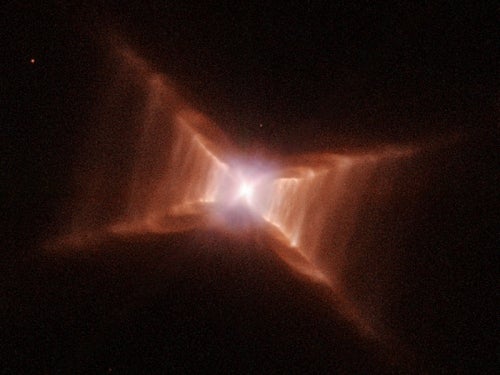that orbit one another every 10 ½ months. Their interaction has probably ejected dust from the disk that obscures our view of the binary. The disk in turn funnels outflows up and away, forming the bizarre structure we see as the Red Rectangle.
Ladder-like structures surrounding a dying star are just one of the features revealed in a new Hubble Space Telescope image of a nebula known as the “Red Rectangle.” Cataloged as HD 44179, this nebula is more commonly known for its unique shape and color visible through ground-based telescopes — but it turns out the Red Rectangle isn’t rectangular after all.
Instead, it’s shaped like an X, which astronomers are interpreting as the product of gas and dust outflows from the star in the center. The star ejects gas and dust in opposite directions, producing a shape like two wineglasses touching at their bases.
The crossbeams of the X are joined by straight features that look like rungs on a ladder, giving the Red Rectangle the appearance of a spider web — a shape unknown among visible nebulae. These rungs have a regular appearance that astronomers believe was caused by mass ejections from the star every few hundred years. The reasons for these periodic ejections remain unknown.
The Red Rectangle lies about 2,300 light-years away from Earth in the direction of the constellation Monoceros. The star at its center used to be Sun-like, but around 14,000 years ago, it started ejecting its outer layers and producing the nebula visible today. In a few thousand years, the star will be smaller and hotter and will begin to release a flood of ultraviolet light into the surrounding nebula. This will cause gas in the nebula to fluoresce, producing what astronomers call a planetary nebula.
Right now, however, the central star is still so cool that the atoms in the surrounding gas don’t glow. The surrounding dust particles are visible only because they reflect light from the central star. Mixed in with these dust particles are molecules that emit red light. Astronomers think these molecules might be hydrocarbons formed in the cool outflow from the central star.
Another feature of the Red Rectangle that hasn’t been seen before is the dark band obscuring the central star. The dark band is the shadow of a dense disk of dust that surrounds the star and blocks a direct view. But astronomers have discovered that the central star is actually a binary, a close pair of stars orbiting each other with a period of about 10 ½ months. The interactions between these stars probably created the thick cloud of dust obscuring our view. The disk has funneled subsequent outflows from the star, forming the bizarre biconical structure we see as the Red Rectangle.
The Red Rectangle was discovered during an early 1970s rocket flight in which astronomers were searching for strong sources of infrared radiation. This image was made from observations taken on March 17-18, 1999, with Hubble’s Wide Field and Planetary Camera 2.










